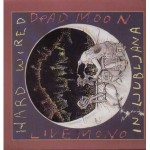 Dead Moon
Dead Moon
Hard Wired In Ljubljana
Empty Records
For the past twenty years, the venerable Godparents of Portland Punk, Fred and Toody Cole have held sway over the alternative scene, first with the Rats and for the past decade with Dead Moon. Joined by faithful drummer Andrew Loomis, Dead Moon have toured the world over propounding their roughshod brand of power Pop to the masses, acquiring a loyal coterie of fans along the way. This album of 20 songs, recorded live in LjubLjana, which lies just south of the Austrian border in what was once eastern Yugoslavia, neatly captures the raw energy the band projects on stage.
There are no surprises on this decidedly lo-fi outing. It’s not as if the Moonies went out on the road with a synth player, a horn section and a string quartet to perform their long awaited rock opera. But Fred’s cranky, screechy voice and strangled guitar never sounded better, Toody’s rumbling bass and ragged vocals never more inspired, Andrew’s trashy drums never so spirited. Most of the 18 original tunes captured here were culled from the band’s two most recent studio albums, although a few Cole-penned classics find their way onto the list as well.
“Room 215” is a jagged piece of glass slashed across a greasy window shade. Andrew’s barely restrained percussion threatens to explode beneath Fred’s craggy vocal fusillade. Something of a rewrite of Creedence Clearwater’s “Lodi,” “Somewhere Far Away” adds a Country flavor to the mix; red, white and blue sentiment for Slavic sensibilities.
Toody takes the vocal lead on the rough and tumble rocker “13 Going On 21,” sounding as tough and bitchy as Patti Smith in her prime. Fred leads the troops through a rousing version of “Poor Boy,” a snickering strut with the catchy verse, “I was wasted, I was dumb struck/I wake up in the bottom of some… being loaded in a dump truck.”
The trio actually do add a fourth member to the cast on the swampy mojo of “Killing Me,” enlisting the services of Sjef Huurrdeman on harmonica, to great effect. His eerie, elegant solo sounds like the wailing of a banshee under a dead moon. One of the band’s trademark tunes, ‘Fire In The Western World,” is rendered like a brimstone sermon from the pits of Hell, Fred’s urgent screams gurgling within the boiling cauldrons of eternal damnation.
Toody returns with a savage rendition of “Cast Will Change,” spitting out the lyrics like a rebellious kid. With “Spectacle,” Fred offers an alternative view of what Talking Heads might have sounded like had David Byrne elected to forego medication, Fred’s rueful howl echoing in the Ljubljana darkness. “Kicked Out, Kicked In” is a roiling rant, motivated by Andrew’s surfy drum work and Fred’s characteristically furious vocals.
Sounding like a shaman with a bad headache, Fred’s take on the traditional tune “Milk Cow Blues” melts the song down to its component molecules, recalling the Rolling Stones in their dear old early dirty days. Speaking of the Stones, Toody’s interpretation of their early hit, “Play With Fire” adds a new dimension to the narrative. Fred’s searing anthem “Diamonds In The Rough” closes out the set with an extended solo segment that broadens the bands boundaries a bit.
Dead Moon are nothing if not consistent. Somehow, after thirty years of igniting their rage, Fred and Toody Cole still find the emotional gasoline to throw on the fire and the physical stamina to withstand it. They are true legends of Northwest music, the founders of a sound that is indeed too tough to die, too volatile to bottle, too dangerous for stereo. The local shot heard ’round the world.
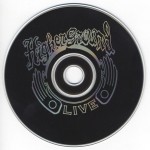 Higher Ground
Higher Ground
Higher Ground Live
Self-Produced
After undergoing personnel changes in early 1997, with the departure of singer/songwriter David Kronenberg and bassist Charles Masi, remaining founders, drummer Josh Biggs and singer/songwriter/multi-instrumentalist Alan Glickenhaus brought the ubiquitous mandolinist/guitarist Mick Chegwidden on board, along with bassist Chris Miscow, to resurrect the band. This live recording was captured at Mt. Tabor Pub last September, commemorating the bands re-emergence onto the local scene.
And, to be honest, the band pretty much sounds the same, with a good timey attitude, covering elements of Bluegrass, Country Swing, Rock and Americana with cross-pollination aplenty, such as the Funk elements in the essentially New Grass instrumental “Quick Sand,” or the African/Bluegrass textures of “Alpaca Sweater” and the aptly named instrumental “Afrolachia.”
The music is a tad schizophrenic at times, skipping from style to style with reckless abandon. But at other times, interesting new hybrids burst to flower, such as the aforementioned African and Funk Bluegrass combos. Many of the arrangements are designed to showcase Glickenhaus’ talents on fiddle, banjo and mandolin (along with Chegwidden). Several of the fifteen tunes included here are instrumentals, dispensing with the pretext of song structure altogether, allowing Glickenhaus and Chegwidden to cut to the solo chase immediately.
“Goin’ Home” utilizes the stereotypical “truckin'” metaphor, lyrically and musically, to get its point across, smartly played but nothing new. The instrumental “Rockslide” features Glickenhaus on electric violin and steers between New Age semantics and “Orange Blossom Special” bluster.
“Cluck Go The Chicken” is a finger lickin’, chicken pickin’ hidee hoedown. Closer to a Rock tune, “Texas Tornado” coasts like the Doobies or the Dead, opening up in the middle for Glickenhaus’ tasty extended guitar solo. “Afrolachia” combines Miscow’s sinewy African flavored basslines and Chegwidden’s syncopated guitar with Glickenhaus’ saxy electric violin tones, colored by Bluegrass and Irish hues, for an enjoyably unique stew.
Glickenhaus cuts loose on electric banjo for the grassy “Upum Gulch,” navigating through some nifty runs in the turns and breaks. The instrumental “Quick Sand” melds Chegwidden’s David Grisman-inspired mandolin phrasings, while Miscow and Biggs create a funky foundation. Chegwidden kicks the mandolin into overdrive for a smoldering solo, utilizing lead guitar tricks to create a genre bending fusion of styles. Very cool.
Chegwidden takes a crack at lead guitar, while Glickenhaus adds violin to the upbeat rock cornpone of “Pop Song.” Glickenhaus gets a turn on mandolin with the Grismanesque instrumental “Freeborn Man.” Chegwidden’s blazing guitar solo helps to push the tune in a different direction. “Alpaca Sweater” again utilizes the African textures of Miscow’s bass and Chegwidden’s guitar, as Glickenhaus lays in the Bluegrass mandolin.
This nicely recorded live performance gives clear evidence of Higher Ground’s versatility and adeptness at creating new and interesting musical aggregates. The songwriting and vocals here are mostly pedestrian? not bad, but far from inspiring. The band is at their best when concocting their offbeat instrumentals, where their stellar musicianship can shine without being confined by the limitations of traditional song arrangements. While the band went through major changes in 1997, it is clear that the current members have taken the higher ground.
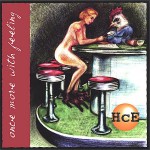 Here Comes Everybody
Here Comes Everybody
Once More With Feeling
Refrigerator Records
The husband and wife team of singer/drummer Michael Jarmer and keyboardist René Ormae-Jarmer have been treading the boards in Portland for the past fifteen years, for the past ten as Here Comes Everybody. In that time, the pair have acquired a reputation for constructing quirkily eclectic pop songs along the lines of David Byrne and Adrian Belew. Here, they make no concessions, creating dense, intellectually challenging material that offers no quarter to the dunderheaded.
The most noticeable difference between this and previous HCE recordings, is René’s migration away from the utilization of synth tones in her keyboard backings, toward the use of straight piano and organ settings. “Made Of Something” is perhaps the most successful pairing of René’s dense piano articulations and Michael’s unorthodox lyrical musings: “I know a boy made of cheese/Leave him out he’ll grow rancid and mold/And he’s got gelatin behind his knees/Keep him refrigerated or he’ll liquefy.”
“Seven And A Half Feet Tall” juxtaposes René’s jaunty accordion with a driving synth cello line, before whipping into a frenzied two-step brawl in the body of the song, calling to mind XTC’s “Ten Feet Tall” from the early days of the first British New Wave invasion in the late ’70s. Similarly, “Her Heart Is A Bog” resembles XTC as well, but more like the XTC of the late ’80s and early ’90s. Over a rubbery bassline provided by John Huckfeldt of Gravelpit, René layers chunky piano chords and samples of la-la human voices, possibly lifted from David Bowie’s “Fashion,” while Michael vocalizes in two octaves and guest guitarist Jeff Bryner adds jagged guitar riffs.
René decorates “How Do You Laugh” with a moody, cascading piano figure, as Michael contributes his most sensitively direct and melodically developed lyric in some time. Instead of relying upon a steady stream of glib one-liners, he constructs a forceful scenario of real emotional depth. “Holier Than Thou” strikes a Zappa-like pose with an insistent Martian chorus and a Holy Roller breakdown worthy of the Pastor Rod Flash from Firesign Theatre.
“Ba Ba” employs a curious coalescence of styles, applying Beach Boysesque background vocals to rumbling sax charts and a Belewish sensibility, with Jazz undertones, creating a most unusual pastiche. A Jazz component is woven through René’s spatial piano work on “The Love Thing,” echoed even more deeply in the richly chorded intro to “To Be Alive.”
Here Comes Everybody’s music is difficult, there is no way around it, it is built to confound and perplex. Michael Jarmer’s lyrics are generally filled with disdain for the foibles of Everyman. When he rises, even slightly above the level of misogyny, as with “How Do You Laugh” or “To Be Alive,” his diatribes can be found to be eloquent and nearly elegant. René Ormae-Jarmer’s ornately exquisite piano work also lends the music a more human, less mechanical feel than in times past; making the overall effect less strident and more organic.
These small moves toward a spirit of universality are bound to reap benefits for HCE in helping them to acquire a following. In the past, their intellectual snobbery has tended to limit the extent of their message. While that particular hurdle has yet to be completely vaulted, the band has made one small step in that direction.
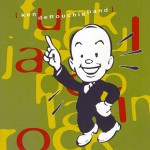 Ken Derouchie Band
Ken Derouchie Band
Funk Soul Jazz Pop Latin Rock
Self-Produced
Ken Derouchie, who was last seen haunting the local clubs with the Goth unit Monde La Bella, displays chameleon colors; returning with a horn infused sound seemingly modeled upon the success of avant lounge bands such as Pink Martini and Jesus Presley. That statement seems well-founded in light of the fact that current and former members of both bands play integral roles in this incarnation. The rest of the band Ken has assembled are quite capable (and in one case superior). The resultant sound is well hewn, if somewhat faceless and fragmented in its construction.
And of the six musical styles alluded to in the album title, only Pop and a Little Feat brand of Funk really qualify. Derouchie’s gruff baritone, recalls at times Terry Kath of early Chicago and other times Gregg Allman. His guitar stylings, primarily recorded direct, resemble the shimmery slickness of Pablo Cruise or Little River Band, rocking with about the same authority. The Soul aspect, evidently provided by a trio of horns, most resembles Al Kooper’s original experiment with Blood, Sweat & Tears and early Chicago. The Latin flavor would be attributable only to the occasional percussive implement bubbling up in the mix; the Jazz, a passing nod in the direction of Windham Hill.
The true bright spot in the set of ten original numbers and a cover of Bill Withers’ “Ain’t No Sunshine,” is John Fresk, a man with few peers when the subject is a Hammond B-3 organ. Most comfortable in a Blues related format, Fresk displays a vital knowledge of the instrument in its most intrinsic elements. But even a musician of Fresk’s caliber is occasionally miscast in a role where perhaps some other keyboard instrument might better succeed.
“Papa” sounds like something Electric Flag might have done, while “Something More” circles around a soulful arrangement more closely aligned to Chicago. The instrumental “Get With You” is a showcase for Fresk’s mighty talents. “You Don’t Know Me” moves along more Blues oriented lines, with an Allmanesque feel.
A collision of rhythms jumbles the intro to “Cover Me,” before resolving into a dark, mysterious mood, motivated by Fresk’s propulsive organ. “The Way You Care” is a strange arrangement of a strange song that never quite gets off the ground. The band’s take on “Ain’t No Sunshine” is full-bodied, the basic blues structure of the song yielding fertile musical soil for Fresk to till with the gusto of a farmboy in a cornfield. “In The Open” is a stab at a Funk feel, that Fresk fleshes out with a dazzling Jazz tinged solo over staccato horn interjections.
The most telling number is the final one. “Autumn” is a facile soft-Jazz/New Age instrumental that offsets muted trumpet intonations against Fresk’s open-chorded, richly arpegiated piano phrasings and a dusky sax solo. This is the obvious direction for the band to pursue, the style with which they are the most comfortable and at which they excel.
John Fresk can duke it out with any of Portland’s best organ players. He has a rich palette from which to draw his Hammond conclusions. The rest of the band hold their own in attempting to lend musical diversity to songs that don’t always warrant such trappings. Derouchie contributes a workmanlike vocal performance throughout, if lacking in any actual emotional connection to his material.
While there are no real dogs on this outing, neither do any real hits stand out. Instead, the Ken Derouchie Band’s material traces middle ground where everything is safe and predictable: no dangerous curves or gravel spitting spinouts. Everything is under control? no hazards on this musical freeway. The speed limit is 55 and it’s never exceeded. All the markers are where they are expected to be. Next stop: Salem, and Albany beyond. Zoom.
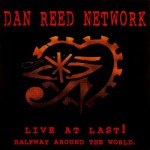 Dan Reed Network
Dan Reed Network
Live At Last!
Self-Produced
It’s been nearly five years since the Dan Reed Network ended their decade-long reign as Portland’s premier touring and recording act? time enough for an objective assessment of their work. A two-disc, two and a half hour long, 33 song compilation is beyond the ken of most bands: who typically have great difficulty maintaining the only ten songs they know in order to get through a set. Here the Network up the ante by releasing a live compendium, recorded over a five year period from 1989 to 1993, in locales as foreign and far away as Sydney, Australia; Visby, Sweden and Prague, Czechoslovakia, to places just down the street, such as the Aladdin Theatre and the Masonic Temple.
All the hits are here: “Under My Skin,” “Tiger In A Dress,” “Get To You” and “Ritual.” In fact, just about everything (and more) that the band ever recorded in the studio has a live counterpart here. And in that point is probably the most obvious aspect about this recording. While, in the studio the band had a slick, Princely sound, their live sets rocked hard. Bassist Melvin Brannon II and drummer Dan Pred slam out chunky dance rhythms, while guitarist Brion James wails on guitar and Blake Sakamoto provides the dense strata of keyboard sounds.
The album kicks off with “Slam Swirl,” a clever collage comprised of various band intros, in an array of languages, overlain with huge crowd sounds and washes of strange synth sounds. “Under My Skin” burns under heat of James’ guitar, as Brannon struts with a swanky bassline and Pred whacks out the high-stepping beat. with Sakamoto adding the staccato synth horns. Reed completes the big-time picture with a hard hitting vocal.
James’ snaky guitar lick wraps itself around Brannon’s fat bass on “Blame It On The Moon,” where the incessant crowd noise sounds like jets taking off from Sydney International Airport. Brion stretches out with a tasty extended solo. Reed’s intelligent rap in “Mix It Up” is nicely balanced by Sakamoto’s symphonic synth orchestrations and tight harmonies through the chorus. A very hip sound, even five years later.
Reed’s pretty elegy to Bill Graham, “Rainbow Child” is a satisfying change of pace, a tender ballad with a very Prince-like feel. And the anthemic qualities of “Lover” certainly seem to go over well with the London crowd of 1990.
But the difference in sound and technical prowess between those days and a recording culled from the last days in 1993, such as “Burnin’ Love” give clear evidence of the maturation the band achieved in all that time spent traveling the world. Sakamoto’s lilting synth string part seems to prefigure a similar line found in The Verve’s “Bittersweet Symphony.” James gets the chance to shine on the rocking intro and solos in “Come Back Baby,” coming together with Sakamoto’s synth pads for a big push on the choruses, while Reed leads the band through a stadium-sized arrangement of the highest magnitude. First rate.
The oldest and perhaps most highly stylized track is a 1989 take of “Tiger In A Dress,” sounding very close to the studio version, and very dated in a late ’80s kind of way. Later recordings featured here, such as 1993’s “Love Don’t Work That Way” find the band forging a new sound that makes use of Metal and Rap elements as well as the emerging trend of that day: Grunge. And the tight harmonies, percolating ensemble work and glorious solo flashes of “Forgot To Make Her Mine.”
Despite the passage of time, “Ritual” still ripples with energy, Sakamoto’s chiming synth riff captures the spirit of the chorus, with ghostly flute tones haunting the bridge. Brion James takes a turn at the lead vocal mic with “Chill Out,” a honky tonk skiffle reminiscent of Mungo Jerry’s “In The Summertime.” Speaking of covers, the band tosses in interesting interpretations of the Doobies’ “Takin’ It To The Streets” and Randy Newman’s “You Can Leave Your Hat On.”
Saving the best for last perhaps, “Seven Sister’s Road” seizes an Aerosmith stance and whips a throng of Swedish fans into a raving frenzy, demonstrating more than any studio album ever could, the Network’s electric appeal with an arena-sized crowd. And that is a side of the band that may have gone unnoticed by the folks back home in Portland, Oregon? a lot of people all over the world went really crazy for Dan Reed and the Network. This recording certainly documents that fact in a big way.
Two and a half hours might be a bit of a stretch, even for die-hard fans or those who missed the exciting dynamism of the Dan Reed Network the first time around. But there is no getting around the consistently high level of musicianship among Dan and his quartet of pros. Live At Last chronicles the long, long road the band traversed and the rich musical rewards they unearthed in their travels. It stands as the legacy of a band and an era now gone.
